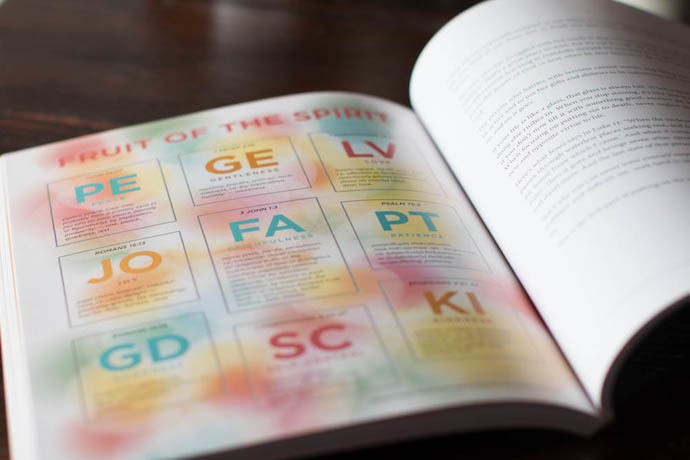Several years ago our church experienced an unexpected surge of growth. The majority of those who arrived in that surge were young adults who loved the Lord but had not received consistent teaching on how to live as Christians. As one of their pastors, I longed to see them grow in their knowledge of God so they could, in turn, live for his glory. I did not know it at the time, but it was here that Visual Theology was born.
Want a free infographic? You can download The Fruit of the Spirit right now.
Bought the book? Submit your receipt and get two bonus graphics.
Visual Theology is a book that offers systematic teaching on how to live the Christian life. There are many excellent resources that are meant for new believers or for believers eager to spur on their growth in knowledge and holiness. The majority of the resources are essentially short systematic theologies and, while systematic theology is good and crucial, I wanted to focus instead on systematic Christian living.
Over the course of a series of Sunday afternoons and evenings, I opened up classes to teach about the Christian life. We began with foundational matters such as the centrality of the gospel and understanding our new identity in Jesus Christ. From there we progressed to learning the importance of growing in our knowledge of both the doctrine of the Bible and the drama of what God means to accomplish in his world. We looked at how God calls us to put sin to death and how to come alive to righteousness. And then we looked at specific parts of life—vocation, relationships, marriage, sexuality, stewardship—and saw how in all of these ways we can live for the glory of Christ.
When all of this was complete I realized I had the beginnings of what might be a helpful book. I teamed up with Josh Byers to experiment in making this an illustrated book that would combine words with infographics. And just like that we had Visual Theology: Seeing and Understanding the Truth About God. The book released on April 19. I’m grateful to everyone who purchased a copy and hope those who haven’t yet will at least consider it!

5 Ways to Put Visual Theology To Work
I’d like to suggest a few ways you may want to consider using this book:
- Read and observe it. The most obvious way to use the book is to simply read it while also looking at the graphics. We intended to create graphics that would complement the words, adding visual learning to the standard textual learning.
- Read it with your family. We deliberately prepared the book to appeal to a wide range of people. And, indeed, much of the teaching that led to the book was done in front of a full congregation of children and adults. We believe Visual Theology will serve as an ideal book for parents to read with their family, especially with older children. It might also make a good homeschool resource.
- Read it with your group. Already I know of peer groups that are reading the book together. It could also be a candidate for men’s or women’s meetings. I believe it will be especially attractive to those who have little natural interest in reading (you know who you are…).
- Give it as a graduation gift. The book was prepared with a visual generation in mind. Where young people may be convinced that theology and Christian living are a bit drab, we hope this book will have immediate visual appeal that will motivate them to dive deeper.
- Use it as a teaching aid. The book provides a systematic method to teach how to live the Christian life. You can borrow the format and (coming soon!) download and use the graphics to help you as you teach others how to live in this world for God’s glory.
This Visual Theology book is just the beginning. We have a whole collection of additional graphics and resources at www.visualtheology.church with many more graphics (and books?) to come. We are also working on a study guide to accompany this volume.
Want a free infographic? You can download The Fruit of the Spirit right now.
Bought the book? Submit your receipt and get two bonus graphics.
Visual Theology is available wherever good books are sold, including:












